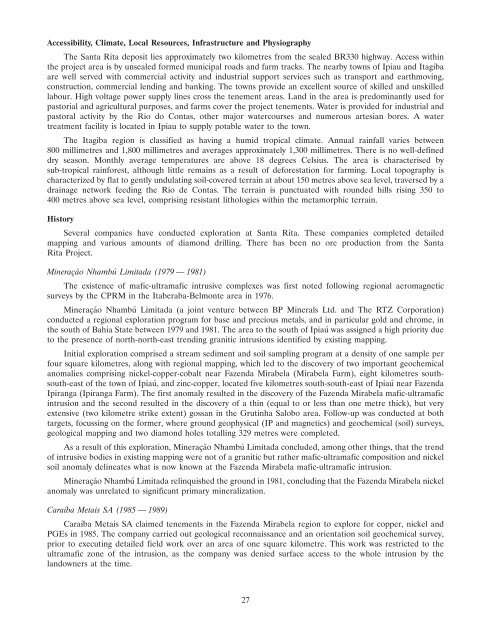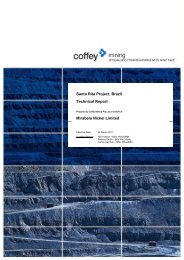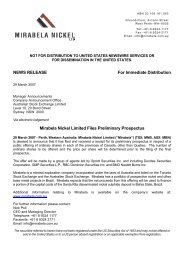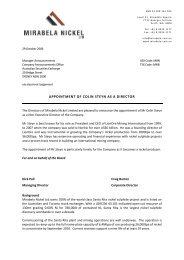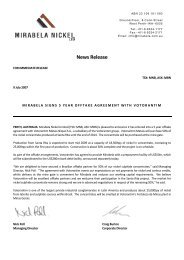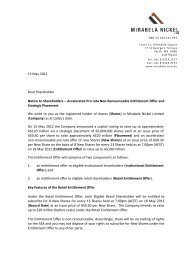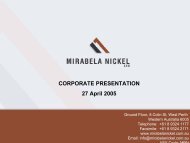COPY OF FINAL PROSPECTUS - Mirabela Nickel
COPY OF FINAL PROSPECTUS - Mirabela Nickel
COPY OF FINAL PROSPECTUS - Mirabela Nickel
You also want an ePaper? Increase the reach of your titles
YUMPU automatically turns print PDFs into web optimized ePapers that Google loves.
Accessibility, Climate, Local Resources, Infrastructure and Physiography<br />
The Santa Rita deposit lies approximately two kilometres from the sealed BR330 highway. Access within<br />
the project area is by unsealed formed municipal roads and farm tracks. The nearby towns of Ipiau and Itagiba<br />
are well served with commercial activity and industrial support services such as transport and earthmoving,<br />
construction, commercial lending and banking. The towns provide an excellent source of skilled and unskilled<br />
labour. High voltage power supply lines cross the tenement areas. Land in the area is predominantly used for<br />
pastorial and agricultural purposes, and farms cover the project tenements. Water is provided for industrial and<br />
pastoral activity by the Rio do Contas, other major watercourses and numerous artesian bores. A water<br />
treatment facility is located in Ipiau to supply potable water to the town.<br />
The Itagiba region is classified as having a humid tropical climate. Annual rainfall varies between<br />
800 millimetres and 1,800 millimetres and averages approximately 1,300 millimetres. There is no well-defined<br />
dry season. Monthly average temperatures are above 18 degrees Celsius. The area is characterised by<br />
sub-tropical rainforest, although little remains as a result of deforestation for farming. Local topography is<br />
characterized by flat to gently undulating soil-covered terrain at about 150 metres above sea level, traversed by a<br />
drainage network feeding the Rio de Contas. The terrain is punctuated with rounded hills rising 350 to<br />
400 metres above sea level, comprising resistant lithologies within the metamorphic terrain.<br />
History<br />
Several companies have conducted exploration at Santa Rita. These companies completed detailed<br />
mapping and various amounts of diamond drilling. There has been no ore production from the Santa<br />
Rita Project.<br />
Mineração Nhambú Limitada (1979 — 1981)<br />
The existence of mafic-ultramafic intrusive complexes was first noted following regional aeromagnetic<br />
surveys by the CPRM in the Itaberaba-Belmonte area in 1976.<br />
Mineração Nhambú Limitada (a joint venture between BP Minerals Ltd. and The RTZ Corporation)<br />
conducted a regional exploration program for base and precious metals, and in particular gold and chrome, in<br />
the south of Bahia State between 1979 and 1981. The area to the south of Ipiaú was assigned a high priority due<br />
to the presence of north-north-east trending granitic intrusions identified by existing mapping.<br />
Initial exploration comprised a stream sediment and soil sampling program at a density of one sample per<br />
four square kilometres, along with regional mapping, which led to the discovery of two important geochemical<br />
anomalies comprising nickel-copper-cobalt near Fazenda <strong>Mirabela</strong> (<strong>Mirabela</strong> Farm), eight kilometres southsouth-east<br />
of the town of Ipiaú, and zinc-copper, located five kilometres south-south-east of Ipiaú near Fazenda<br />
Ipiranga (Ipiranga Farm). The first anomaly resulted in the discovery of the Fazenda <strong>Mirabela</strong> mafic-ultramafic<br />
intrusion and the second resulted in the discovery of a thin (equal to or less than one metre thick), but very<br />
extensive (two kilometre strike extent) gossan in the Grutinha Salobo area. Follow-up was conducted at both<br />
targets, focussing on the former, where ground geophysical (IP and magnetics) and geochemical (soil) surveys,<br />
geological mapping and two diamond holes totalling 329 metres were completed.<br />
As a result of this exploration, Mineração Nhambú Limitada concluded, among other things, that the trend<br />
of intrusive bodies in existing mapping were not of a granitic but rather mafic-ultramafic composition and nickel<br />
soil anomaly delineates what is now known at the Fazenda <strong>Mirabela</strong> mafic-ultramafic intrusion.<br />
Mineração Nhambú Limitada relinquished the ground in 1981, concluding that the Fazenda <strong>Mirabela</strong> nickel<br />
anomaly was unrelated to significant primary mineralization.<br />
Caraíba Metais SA (1985 — 1989)<br />
Caraíba Metais SA claimed tenements in the Fazenda <strong>Mirabela</strong> region to explore for copper, nickel and<br />
PGEs in 1985. The company carried out geological reconnaissance and an orientation soil geochemical survey,<br />
prior to executing detailed field work over an area of one square kilometre. This work was restricted to the<br />
ultramafic zone of the intrusion, as the company was denied surface access to the whole intrusion by the<br />
landowners at the time.<br />
27


